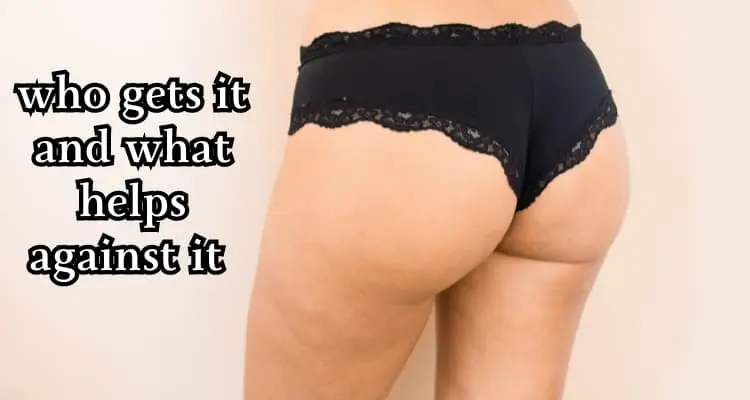Do you have orange peel? Even if it doesn’t comfort you – you’re in good company: Depending on the study, 85 to 98 percent of all women over 20 suffer from Cellulite, i.e. almost all of them. In this case, suffering is more likely to be understood as psychological. Although the unsightly dents and dimples on the buttocks and thighs drive almost everyone affected to despair, they do not cause any physical problems. Modern bubonic plague is a purely cosmetic problem.
None of this is new, just look at a painting by Rubens. The dents, bulges and hardening of the fatty tissue on the surface of the skin are simply part of the body of most adult women. And they didn’t bother with it for centuries. Unfortunately, orange peel does not fit into the current image of the flawless, ageless body. That’s why we’re having such a hard time with it today.
There are anatomical reasons why almost exclusively women get Cellulite. Male and female skin is structured differently. Women’s epidermis is thinner and the underlying dermis is more flexible.
Miss Universe and cellulite
In women, there are more and larger fat cells in the subcutaneous tissue, which are grouped into fat chambers. These can enlarge up to ten times and form food reserves during pregnancy. The fine strands of female connective tissue run perpendicular to the surface of the skin and almost parallel to each other and are therefore very stretchy: small, flexible columns that easily yield to the pressure of the fat chambers.
Enlarged fat cells push up along these columns and form the typical dimples on the surface of the skin. In men, on the other hand, the fat chambers are smaller and firmly anchored in the subcutaneous tissue: the stronger connective tissue does not run vertically, as in women, but horizontally to the surface of the skin; the individual strands are much more strongly networked and even tie together larger amounts of fat into smooth packages.
The hormone estrogen is responsible for the fact that fat is stored in women, especially on the thighs, hips, buttocks and stomach. Although the amount of fatty tissue can influence the extent and development of Cellulite, the corresponding predisposition is genetically determined.
There are no miracle cures
Even women who have always been very slim develop Cellulite if their connective tissue is particularly flexible – a weakness that they have usually inherited. So if your mother suffers from the unpleasant Cellulite, you can expect to develop it too. However, there are risk factors that can influence you: being overweight, for example, or lack of exercise.
Once orange peel has taken hold, it may affect the skin’s metabolism. Blood and lymph, i.e. tissue fluid, can no longer drain well in the connective tissue. Some stimulants such as nicotine, coffee and alcohol constrict the blood vessels – this can also promote Cellulite.

Because almost all women suffer from unwelcome dimples and would like to get rid of them at any cost, Cellulite has become a wide, fertile field for the beauty industry in recent years.
Special creams and gels, salt baths and body oils, tights, new massage devices and lymphatic drainage, but also teas, powders or tablets are intended to make the bumps on the buttocks and thighs disappear. Preferably quickly and effortlessly. However, scientific studies have not yet proven the success of these products.
The best solution: watch your weight
Creams and bath additives at least care for your skin, which is a nice effect. However, dermatologists agree that they do not reach the connective tissue of the subcutaneous tissue and thus the origin of the Cellulite. Massages that promote blood circulation currently stimulate the skin’s metabolism, but they do not address the actual problem.
Many of those affected see surgery as the last resort and have the annoying fat removed by a doctor. But even this is not a silver bullet to smooth thighs and buttocks, not to mention the risk. After the operation, your silhouette will be narrower than before, but the dents and bumps will not disappear completely.
Another solution is the so-called subcision. The skin and subcutaneous fatty tissue are locally anesthetized. A small, sharp cannula is then inserted through an incision, which can be used to carefully loosen strands of connective tissue. The pressure on fat cells, which causes the skin to dilate outwards, should disappear. Of course, tissue can also be injured. Photodynamic therapy, which has previously been used to eliminate skin cancer tumors, is also a form of Cellulite treatment. The light-sensitive substance Temoporfin is injected into the subcutaneous tissue and activated by laser beams. This is intended to cause fat cells to burst. However, the procedure is not yet fully developed and involves risks: fat embolisms can form, and lasering can cause burns and thus scars. Endermologie, on the other hand, is a suction-roll massage that creates negative pressure in the tissue and acts like a deep massage. The only disadvantage is that there are many expensive treatments and the success does not last.
What Is Cellulite Ultimately, there is only one efficient solution to at least reduce the dents: get rid of the extra pounds. But be sure to stay away from crash diets. They only make things much worse because after a radical treatment the fat is stored again very quickly.
The best thing to do is to do what is already good for you: avoid alcohol, cigarettes and too much coffee. Eat a balanced diet. Go hiking, jogging or dancing regularly – this builds muscles, burns carbohydrates and stimulates your metabolism. This is the only way to prevent your fat cells from expanding excessively and causing dents to appear. Someone who exercises simply pays more attention to their diet. And because he is more balanced, he suffers less from small imperfections.
